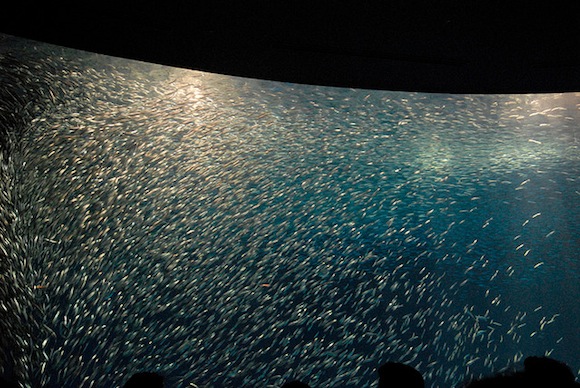
The Nagoyako Aquarium in Nagoya, Aichi Prefecture, is experiencing an unusual problem — lazy sardines. That’s right, according to a recent story on Japanese newspaper Asahi’s digital site, the sardines at Nagoyako Aquarium are not behaving as they should, supposedly because “they have it too easy” in the protected environment of their tank. And in order not to disappoint visitors, it looks like the aquarium will have to call in the “tuna squad” to whip the sardines’ act into shape. But what could be causing these errant fish to misbehave?
The sardines in question — maiwashi or Japanese pilchards to be more exact — are kept in the “Kuroshio Tank” of the aquarium in an environment based roughly on the conditions that exist in the Kuroshio Current off the coast of Japan. The tank, 5 meters (16ft.) tall and 14 meters (46ft.) wide, contains fish of varying sizes that coexist in nature in the Kuroshio environment.
The tank’s main attraction is the “pilchard tornado” created by the sardines as they group together to feed in a large whirl-shaped formation. A splendid sight to behold, this behavior is a defense mechanism on the part of the sardines to protect themselves from larger fish, as rocks and other structures that can provide shelter are typically not found in the offshore waters of the Kuroshio Current. The sardines at the Nagoyako Aquarium too exhibited this characteristic behavior, delighting visitors, and all seemed well in the world of the Kuroshio Tank — until recently, when lone sardines started swimming in a different corner of the tank away from the group.
▼The pilchard tornado, when the sardines are doing what they should be doing
Now, it appears some sardines in the tank have been going rogue and disrupting the tornado teamwork, much to the dismay of the aquarium staff, and the caretakers actually think it may be because the sardines are confident that they won’t be eaten and getting lax with their defenses.
Although the tank is designed within reason to show conditions close to what exists in the natural environment, it obviously wouldn’t do for the larger fish to eat up the sardine population in the tank, so it has been part of the aquarium’s feeding program to keep the larger fish well-fed and full enough not to prey on the sardines. Unfortunately, this may have led to the sardines becoming “over-confident” of their protected status. According to the staff, some of the sardines are even fearless enough to compete for feed with bonito that are three times their size and actually their predators in the wild.
To restore a sense of order among the unruly sardines, the aquarium has decided to add 15 Pacific bluefin tuna into the tank. There are already tuna in the tank, but only two at present, and the aquarium is hoping a larger number will have the effect of “scaring” the sardines back into their usual behavior.
This isn’t the first time attempts have been made to shake up the slacking sardines. A scalloped hammerhead shark that was brought in from Kagoshima Prefecture in southern Japan unfortunately was unable to adapt to the tank’s water temperature and died. Some Japanese Spanish mackerel were also introduced into the tank, only to die from being bitten by sharks. The only type of fish that has been moderately successful in keeping the sardines on their toes (or should I say fins in this case) has been the ocean sunfish. At present, the sardines seem to recognize and avoid the five large sunfish in the tank.
The Asahi article reports that the Kuroshio Tank is currently populated by: 35,000 sardines (Japanese pilchards), 8 mahi-mahi, 7 bonito, 6 blue mackerel, 5 ocean sunfish, 3 African pompano, 2 Pacific bluefin tuna, 1 copper shark and 1 mackerel tuna.
And if further reinforcements are required, the article says the aquarium may also consider introducing Indo-Pacific sailfish into the tank in addition to the tuna. Well, let’s hope the tuna squad does their work and visitors will be able to see the sardines’ magnificent tornado performance for a long time to come. Hmm, but sardines, bluefin tuna and mackerel? I have to say the Kuroshio Tank contains some awfully delicious-sounding fish. Darn, I think I’m getting hungry for sushi now…
For those of you who can’t make it to the aquarium, we’ll leave you with the video from which the above stills were taken. It really is quite a sight!
Source: The Asahi Shimubun Digital (Japanese)

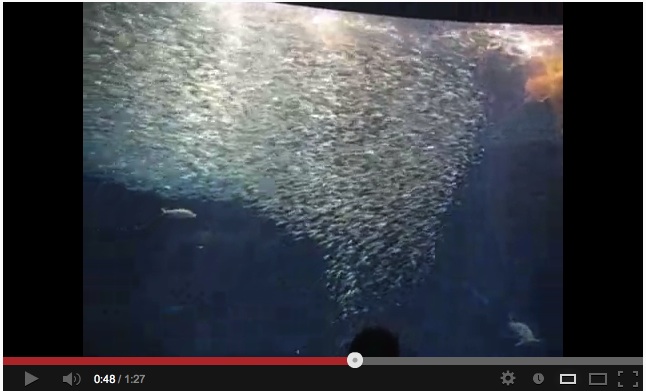
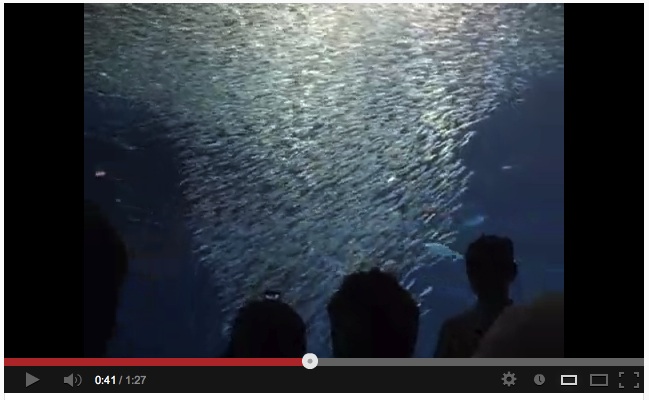
 Over 1,000 fish and other marine creatures die at Tokyo aquarium after failed medical treatment
Over 1,000 fish and other marine creatures die at Tokyo aquarium after failed medical treatment Real-life Japan continues to look like bad Photoshop as penguins “fly” in the Tokyo sky【Photos】
Real-life Japan continues to look like bad Photoshop as penguins “fly” in the Tokyo sky【Photos】 Japanese town suffers population decline, turns its local elementary school into an aquarium
Japanese town suffers population decline, turns its local elementary school into an aquarium Tuna born from mackerel: Japanese scientists develop surrogate tech to save threatened species
Tuna born from mackerel: Japanese scientists develop surrogate tech to save threatened species Tokyo aquarium’s reopening showcases a revamped, ethereally beautiful jellyfish chamber
Tokyo aquarium’s reopening showcases a revamped, ethereally beautiful jellyfish chamber Disney princesses get official manga makeovers for Manga Princess Cafe opening in Tokyo
Disney princesses get official manga makeovers for Manga Princess Cafe opening in Tokyo Our reporter takes her 71-year-old mother to a visual kei concert for the first time
Our reporter takes her 71-year-old mother to a visual kei concert for the first time Is the new Shinkansen Train Desk ticket worth it?
Is the new Shinkansen Train Desk ticket worth it?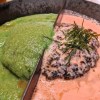 Hamburg and Hamburg Shibuya: A Japanese restaurant you need to put on your Tokyo itinerary
Hamburg and Hamburg Shibuya: A Japanese restaurant you need to put on your Tokyo itinerary Foreign English teachers in Japan pick their favorite Japanese-language phrases【Survey】
Foreign English teachers in Japan pick their favorite Japanese-language phrases【Survey】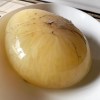 You COULD eat a terrifying octopus egg in Japan, but SHOULD you? Let’s find out!【Taste test】
You COULD eat a terrifying octopus egg in Japan, but SHOULD you? Let’s find out!【Taste test】 Eight Japanese words we’d love to import into English
Eight Japanese words we’d love to import into English Hey, Japanese taxi driver! Take us to your favorite restaurant in Tsuruga City!
Hey, Japanese taxi driver! Take us to your favorite restaurant in Tsuruga City!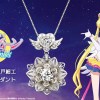 Traditional silverwork pairs with the power of the moon in this stunning Silver Crystal pendant
Traditional silverwork pairs with the power of the moon in this stunning Silver Crystal pendant We try out “Chan Ramen”, an underground type of ramen popular in the ramen community
We try out “Chan Ramen”, an underground type of ramen popular in the ramen community New Studio Ghibli bedding sets are cool in all senses of the word
New Studio Ghibli bedding sets are cool in all senses of the word Our Japanese reporter visits Costco in the U.S., finds super American and very Japanese things
Our Japanese reporter visits Costco in the U.S., finds super American and very Japanese things New Pokémon cakes let you eat your way through Pikachu and all the Eevee evolutions
New Pokémon cakes let you eat your way through Pikachu and all the Eevee evolutions There’s a park inside Japan where you can also see Japan inside the park
There’s a park inside Japan where you can also see Japan inside the park Japanese convenience store packs a whole bento into an onigiri rice ball
Japanese convenience store packs a whole bento into an onigiri rice ball Hanton rice — a delicious regional food even most Japanese people don’t know about, but more should
Hanton rice — a delicious regional food even most Japanese people don’t know about, but more should Final Fantasy, Kingdom Hearts, and Dragon Quest pet product line announced by Square Enix
Final Fantasy, Kingdom Hearts, and Dragon Quest pet product line announced by Square Enix Studio Ghibli releases Kiki’s Delivery Service chocolate cake pouches in Japan
Studio Ghibli releases Kiki’s Delivery Service chocolate cake pouches in Japan Japan’s bone-breaking and record-breaking roller coaster is permanently shutting down
Japan’s bone-breaking and record-breaking roller coaster is permanently shutting down New definition of “Japanese whiskey” goes into effect to prevent fakes from fooling overseas buyers
New definition of “Japanese whiskey” goes into effect to prevent fakes from fooling overseas buyers Foreign passenger shoves conductor on one of the last full runs for Japan’s Thunderbird train
Foreign passenger shoves conductor on one of the last full runs for Japan’s Thunderbird train Kyoto bans tourists from geisha alleys in Gion, with fines for those who don’t follow rules
Kyoto bans tourists from geisha alleys in Gion, with fines for those who don’t follow rules Studio Ghibli unveils Mother’s Day gift set that captures the love in My Neighbour Totoro
Studio Ghibli unveils Mother’s Day gift set that captures the love in My Neighbour Totoro Domino’s Japan now sells…pizza ears?
Domino’s Japan now sells…pizza ears? Toyota built a life-sized Miraidon Pokémon and are letting people test drive it this weekend
Toyota built a life-sized Miraidon Pokémon and are letting people test drive it this weekend New Japanese KitKat flavour stars Sanrio characters, including Hello Kitty
New Japanese KitKat flavour stars Sanrio characters, including Hello Kitty Sales of Japan’s most convenient train ticket/shopping payment cards suspended indefinitely
Sales of Japan’s most convenient train ticket/shopping payment cards suspended indefinitely Sold-out Studio Ghibli desktop humidifiers are back so Totoro can help you through the dry season
Sold-out Studio Ghibli desktop humidifiers are back so Totoro can help you through the dry season Japanese government to make first change to romanization spelling rules since the 1950s
Japanese government to make first change to romanization spelling rules since the 1950s Ghibli founders Toshio Suzuki and Hayao Miyazaki contribute to Japanese whisky Totoro label design
Ghibli founders Toshio Suzuki and Hayao Miyazaki contribute to Japanese whisky Totoro label design Doraemon found buried at sea as scene from 1993 anime becomes real life【Photos】
Doraemon found buried at sea as scene from 1993 anime becomes real life【Photos】 Tokyo’s most famous Starbucks is closed
Tokyo’s most famous Starbucks is closed One Piece characters’ nationalities revealed, but fans have mixed opinions
One Piece characters’ nationalities revealed, but fans have mixed opinions We asked a Uniqlo employee what four things we should buy and their suggestions didn’t disappoint
We asked a Uniqlo employee what four things we should buy and their suggestions didn’t disappoint Princesses, fruits, and blacksmiths: Study reveals the 30 most unusual family names in Japan
Princesses, fruits, and blacksmiths: Study reveals the 30 most unusual family names in Japan Studio Ghibli’s new desktop Howl’s Moving Castle will take your stationery on an adventure
Studio Ghibli’s new desktop Howl’s Moving Castle will take your stationery on an adventure Greenpeace tells Obama to make ‘more responsible’ food choices after meal at restaurant that serves endangered sushi
Greenpeace tells Obama to make ‘more responsible’ food choices after meal at restaurant that serves endangered sushi Which Japanese conveyor belt sushi chain has the best iwashi sardine sushi?【Taste test】
Which Japanese conveyor belt sushi chain has the best iwashi sardine sushi?【Taste test】 Neco Meshi: The line of Japanese snacks that both you and your cat can eat! 【Taste test】
Neco Meshi: The line of Japanese snacks that both you and your cat can eat! 【Taste test】 Garden eels in Japanese aquarium are forgetting humans and need your help!
Garden eels in Japanese aquarium are forgetting humans and need your help! Enjoy the sights and sounds of Art Aquarium any time you like with this miniature home version
Enjoy the sights and sounds of Art Aquarium any time you like with this miniature home version We go hands-on with “Pictuarium”, the virtual aquarium that brings your doodles to life!
We go hands-on with “Pictuarium”, the virtual aquarium that brings your doodles to life! Aquarium in Japan encourages guests to call its fish “delicious-looking”
Aquarium in Japan encourages guests to call its fish “delicious-looking” Chance to feel a shark’s nards and more at Sunshine Aquarium’s “Lots of Sex” Exhibit
Chance to feel a shark’s nards and more at Sunshine Aquarium’s “Lots of Sex” Exhibit Brilliant Art Aquarium takes over Nijo Castle in Kyoto for a spellbinding nocturnal event
Brilliant Art Aquarium takes over Nijo Castle in Kyoto for a spellbinding nocturnal event Shinagawa Station sells unappetizing fish butt onigiri, netizens nauseated
Shinagawa Station sells unappetizing fish butt onigiri, netizens nauseated 【Obituary】 Giant isopod “No.1” found dead after more than five years of not eating
【Obituary】 Giant isopod “No.1” found dead after more than five years of not eating Over 30,000 goldfish on display at Art Aquarium, Tokyo’s newest Instagrammable spot
Over 30,000 goldfish on display at Art Aquarium, Tokyo’s newest Instagrammable spot Elegant aquariums provide a unique space for fish and for above ground plants to grow together
Elegant aquariums provide a unique space for fish and for above ground plants to grow together Awesome Pokémon osechi New Year’s meals elegantly blend Japan’s traditional and pop culture
Awesome Pokémon osechi New Year’s meals elegantly blend Japan’s traditional and pop culture Japanese monk’s breakfasts with cats are the most important/cutest videos of the day
Japanese monk’s breakfasts with cats are the most important/cutest videos of the day Japanese people list their top ten fish, and tuna isn’t number one
Japanese people list their top ten fish, and tuna isn’t number one
Leave a Reply